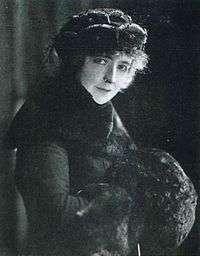Red Light Annie
| Red Light Annie | |
|---|---|
| Written by | Norman Houston and Sam Forrest |
| Date premiered | August 21, 1923 |
| Place premiered | Morosco Theatre |
| Original language | English |
| Genre | Melodrama |
Red Light Annie is a 1923 play written by Norman Houston and Sam Forrest. Producers Sam H. Harris and Albert H. Woods staged it on Broadway. The play is a melodrama about a young couple who move to New York City and are pulled into a world of drugs and crime.
Plot
Tom and Fanny Campbell move from a small town to New York City, where the only people they know are Fanny's stepsister and brother-in-law, Dorothy and Nick Martin. The Martins are criminals who frame Tom for theft. When Tom is sent to prison for three years, Fanny falls prey to cocaine addiction and becomes a prostitute. When Tom is released, Nick attempts to blackmail the Campbells, but Fanny kills him. A sympathetic detective helps her avoid a murder conviction.[1]
Productions
In previews, the play was called The Slavemaker.[2] It appeared under this name in Baltimore in March 1923.[3] After being renamed twice, first to Snow, then to Red Light Annie, the play opened on Broadway at the Morosco Theatre on August 21, 1923. It ran there until October, when it moved to the Eltinge 42nd Street Theatre.[4] The Broadway production closed in early November, having run for 11 weeks with 87 performances.[1]
Cast and characters
The characters and cast from the Broadway production are given below:

| Character | Broadway cast |
|---|---|
| Ned | Al Britton |
| A Man | Albert Carberry |
| Mr. Fulton | Francis Dunn |
| Nick Martin | Edward Ellis |
| Flo | Monita Gay |
| An Office Boy | Billy Gillen |
| A Judge | Harry Hammill |
| Dorothy Martin | Warda Howard |
| Marie | Ann Martin |
| Another Man | Fred McLean |
| Robert Dugan | Paul Nicholson |
| Mr. Wilson | W.H. Prendergast |
| Fanny Campbell | Mary Ryan |
| Tom Campbell | Frank M. Thomas |
| Chester | Henry Vincent |
| Al | John Waller |
| Mr. Clark | Edward Walton |
Dramatic analysis
The play's most unusual feature was the first act, which consisted of ten short scenes in quick succession, showing Tom and Fanny's transition from small-town innocents to degraded city dwellers. The second and third acts were more conventionally staged.[1]
References
- 1 2 3 Bordman, Gerald (1995). American Theatre: A Chronicle of Comedy and Drama, 1914-1930. New York: Oxford University Press. p. 211. ISBN 0-19-509078-0.
- ↑ "News and Gossip of the Rialto". The New York Times. 72 (23,885). June 17, 1923. p. 7:1.
- ↑ "Exits and Entrances". Oakland Tribune. 98 (73). March 14, 1923. p. 13 – via Newspapers.com.

- ↑ "Rialto Gossip". The New York Times. 73 (24,011). October 21, 1923. p. 8:1.